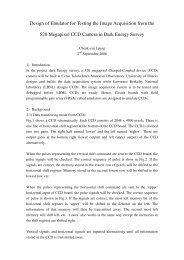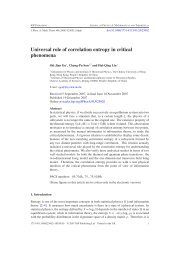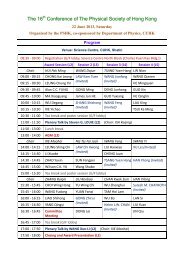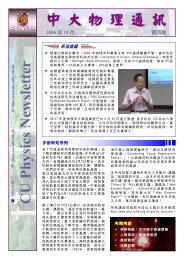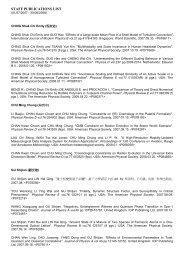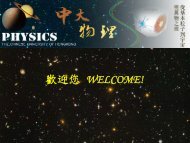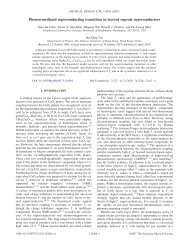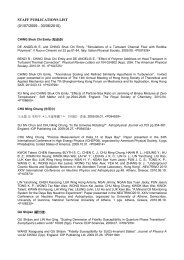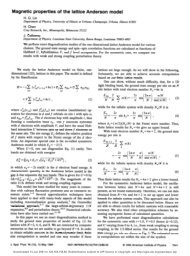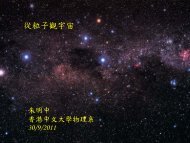19th Issue (Oct-2012) - Department of Physics - The Chinese ...
19th Issue (Oct-2012) - Department of Physics - The Chinese ...
19th Issue (Oct-2012) - Department of Physics - The Chinese ...
Create successful ePaper yourself
Turn your PDF publications into a flip-book with our unique Google optimized e-Paper software.
C. N. Yang<br />
Int. J. Mod. Phys. A <strong>2012</strong>.27. Downloaded from www.worldscientific.com<br />
by THE CHINESE UNIVERSITY OF HONG KONG on 10/09/12. For personal use only.<br />
Between 1954 to 1956 many new particles were found. Particularly interesting<br />
were two particles θ and τ, which decay into two or three π mesons:<br />
θ → π + π,<br />
τ → π + π + π.<br />
Increasingly more accurate experiments showed that θ and τ have approximately<br />
the same masses and the same lifetimes, indicating they might in fact be the same<br />
particle which had two different modes <strong>of</strong> decay. <strong>The</strong>re is nothing strange about<br />
this EXCEPT IT WOULD VIOLATE THE LAW OF PARITY CONSERVATION:<br />
Accordingtothislawthe“parity”<strong>of</strong>twoπ’s is +1 and <strong>of</strong> three π’s is −1. If θ and<br />
τ are the same particle then it can decay into +1 parity and also into −1 parity.<br />
Parity is thus not conserved. That is absolutely impossible! This dilemma was called<br />
the θ–τ puzzle and was the most puzzling problem in fundamental physics in the<br />
years 1954 to 1956. In a 1957 paper I said: 12<br />
<strong>The</strong> situation that the physicist found himself in at that time has been<br />
likened to a man in a dark room groping for an outlet. He is aware <strong>of</strong> the<br />
fact that in some direction there must be a door which would lead him out<br />
<strong>of</strong> his predicament. But in which direction?<br />
In the summer <strong>of</strong> 1956 T. D. Lee and I (Fig. 10) were trying to find this door.<br />
After carefully examined the five types <strong>of</strong> experiments which had been considered<br />
to have established parity conservation in β-decay, we found to our surprise that in<br />
fact none <strong>of</strong> them had proved parity conservation: all<strong>of</strong>themwerenot complicated<br />
enough. We also pointed out several kinds <strong>of</strong> more complicated experiments which<br />
could decide whether parity was conserved in weak interactions such as in β-decay. a<br />
Fig. 10. T. D. Lee and I (taken at IAS in 1957).<br />
a Weak interactions include the decay <strong>of</strong> θ, τ, etc.andalsoβ-decay.<br />
1230009-14



